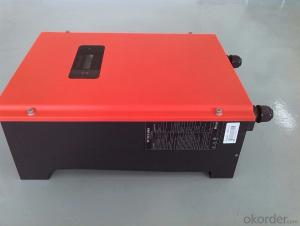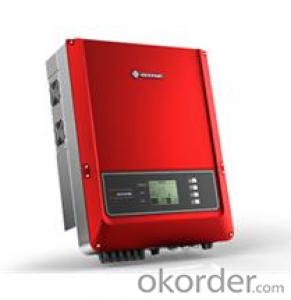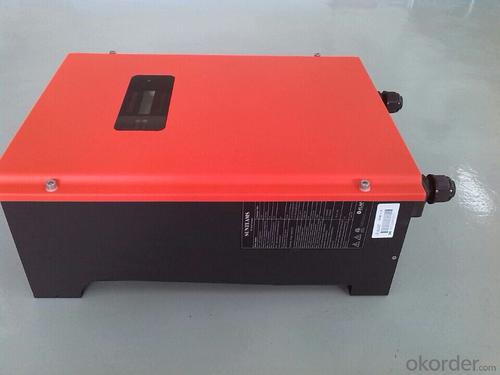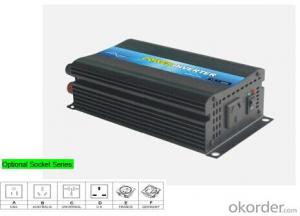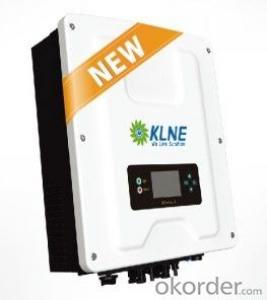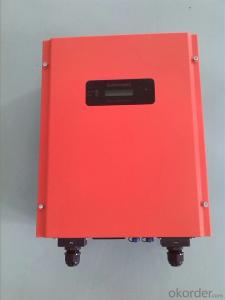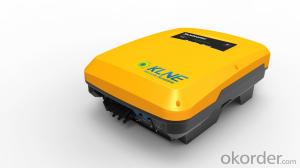Samsung Solar Inverter Off-Grid Type Solartec D 6000/8000
- Loading Port:
- Shanghai
- Payment Terms:
- TT OR LC
- Min Order Qty:
- 10 unit
- Supply Capability:
- 1000 unit/month
OKorder Service Pledge
OKorder Financial Service
You Might Also Like
Product Description:
The photovoltaic grid-connected inverter series of Solartec D 6 - 8 kW are applicable to all types of commercial rooftop projects or grid-connected power plant systems. The nominal output powers of this series are 6 kW and 8 kW respectively.
This series of inverters has 2 string MPP trackers and three level technology. These features ensure the high utilization rate of grid and maximize the system efficiency. The new technology of this series supports the adjustable power factor and grid monitoring, complies to German BDEW medium voltage guidelines and reaches European and Australian certification standards .
Efficient
■ Maximum efficiency 98 %
■ Flexible tracking with two MPP trackers
Reliable
■ Integrated DC switch
■ Three phase grid connection
■ Reliability and long life ensured by film capacitors
Flexible
■ DC input voltage up to 1,000 V
■ Reactive power supply
■ For indoor and outdoor installation
Communicative
■ RS232 / RS485 interfaces as standard
Product Datasheet:
Solartec D 6000 | Solartec D 8000 | |
Input Data | ||
Max. DC Power | 6350 W | 8250 W |
Max. DC Voltage | 1000 V | 1000 V |
System Start-up Voltage | 250 V | 250 V |
Full Load Voltage Range MPPT | 250 V - 800 V | 250 V - 800 V |
Max. Input Current | 2 × 16A | 2 × 16A |
Nominal DC Voltage | 650 V | 650 V |
Number of MPP Trackers | 2 | 2 |
Strings of each MPPT | A : 1, B : 1 | A : 1, B : 1 |
Output Data | ||
Nominal AC Output | 6000 W | 8000 W |
THD of AC Current | < 3.0 % | < 3.0 % |
Nominal Grid Voltage Range | 230 V - 400 V (3/N/PE) | 230 V - 400 V (3/N/PE) |
Nominal Grid Frequency | 50 Hz | 50 Hz |
Adjustable Displacement Factor | 0.9 overexcited...0.9 underexcited | 0.9 overexcited...0.9 underexcited |
Max. Output Current | 10 A | 13 A |
Efficiency |

Product Advantages:
Powered by DC current
Can used out of doors
High effiency and low noise
FAQ
What is your payment terms?
We accept T/T payment, normally we need 20% T/T in advance, 80% payed before shipment.
What is your packing system?
We put the sistem in the wooden box.
Can you do OEM service?
Yes we can, but we need to do it with a certain order quantity.
- Q: How does a solar inverter handle overloading?
- A solar inverter handles overloading by constantly monitoring the power output from the solar panels. If the demand for electricity exceeds the maximum capacity of the inverter, it automatically reduces the power output to a safe level. This prevents the inverter from getting damaged and ensures a stable and reliable power supply.
- Q: How does a solar inverter handle voltage phase imbalance in the grid?
- A solar inverter handles voltage phase imbalance in the grid by continuously monitoring the grid's voltage and frequency. If it detects any phase imbalance, it adjusts its output to balance the voltage across all phases. This ensures that the power generated by the solar panels is synchronized with the grid and prevents any issues that may arise due to phase imbalances, such as equipment damage or power quality issues.
- Q: What are the communication protocols used in solar inverters?
- Solar inverters commonly use several communication protocols to enable communication with other devices or systems. Some of the most frequently employed communication protocols in solar inverters include: 1. Modbus: Modbus is an extensively utilized communication protocol for industrial devices, including solar inverters. It facilitates the transmission of data between the inverter and other devices, such as monitoring systems or data loggers. Modbus is well-regarded for its simplicity and flexibility, which contribute to its popularity in the solar industry. 2. SunSpec: SunSpec is a communication protocol specifically designed for the solar industry. It establishes a standardized means for solar inverters to communicate with other devices, such as smart meters or monitoring systems. SunSpec supports both wired and wireless communication, allowing for effortless integration of solar inverters into larger energy management systems. 3. CAN bus: CAN (Controller Area Network) bus is a widely employed communication protocol in various industries, including automotive and industrial applications. It is a robust and reliable protocol that enables high-speed communication between devices. Some solar inverters employ CAN bus to communicate with other devices or systems, ensuring a dependable means of data transfer. 4. Ethernet: Ethernet is a prevalent communication protocol in the IT industry and is also utilized in certain solar inverters. By utilizing Ethernet, solar inverters can communicate with other devices or systems over a local area network (LAN) or the internet. Ethernet offers high-speed communication and can accommodate various communication standards, making it a versatile option for solar inverters. It is essential to note that different solar inverter manufacturers may employ different communication protocols or a combination thereof. The selection of a communication protocol depends on factors such as the specific requirements of the system, compatibility with other devices or systems, and the desired level of integration.
- Q: Can a solar inverter be used with a generator as a backup power source?
- Yes, a solar inverter can be used with a generator as a backup power source. The solar inverter can be connected to the generator's output, allowing it to convert the generator's AC power into usable DC power for charging the batteries or powering the solar energy system. This setup ensures uninterrupted power supply during periods of low solar generation or in case of power outages.
- Q: What is the efficiency rating of a solar inverter?
- The efficiency rating of a solar inverter refers to the percentage of solar energy that is converted into usable electricity. It indicates how effectively the inverter can convert the direct current (DC) power generated by solar panels into alternating current (AC) power for use in homes or businesses. Higher efficiency ratings mean less energy loss during the conversion process, resulting in more electricity being available for consumption.
- Q: Can a solar inverter be used with different types of communication protocols?
- Yes, a solar inverter can be used with different types of communication protocols. Modern solar inverters are designed to be compatible with various communication protocols such as Wi-Fi, Ethernet, Modbus, and RS485. This allows for seamless integration and monitoring of the solar inverter with different types of monitoring systems, smart home devices, or energy management systems.
- Q: Can a solar inverter be used in remote areas?
- Yes, a solar inverter can be used in remote areas. Solar inverters are commonly used in off-grid systems to convert the DC power generated by solar panels into AC power that can be used for various applications. These systems are particularly beneficial in remote areas where access to the electricity grid is limited or non-existent. By harnessing solar energy, a solar inverter can provide reliable and sustainable power to remote communities, powering homes, schools, clinics, and other essential infrastructure.
- Q: Can a solar inverter be used with a solar-powered cooling system?
- Yes, a solar inverter can be used with a solar-powered cooling system. A solar inverter is responsible for converting the direct current (DC) electricity generated by solar panels into alternating current (AC) electricity that can be used to power various appliances, including cooling systems. By integrating a solar inverter into a solar-powered cooling system, the system can effectively harness solar energy to operate and provide cooling without relying on external power sources.
- Q: What safety features should a solar inverter have?
- A solar inverter should have various safety features to ensure safe and reliable operation. These features include overvoltage and undervoltage protection, short circuit protection, ground fault protection, temperature monitoring and protection, and anti-islanding protection. Additionally, it is important for a solar inverter to have proper electrical insulation and grounding to minimize the risk of electric shock.
- Q: What is the role of a cooling system in a solar inverter?
- The role of a cooling system in a solar inverter is to regulate and maintain optimal operating temperatures to prevent overheating. This is crucial because excessive heat can degrade the performance and lifespan of the inverter, leading to reduced efficiency and potential failure. The cooling system helps dissipate heat generated by the inverter's components, ensuring smooth and efficient operation, and ultimately enhancing the overall reliability and longevity of the solar inverter.
Send your message to us
Samsung Solar Inverter Off-Grid Type Solartec D 6000/8000
- Loading Port:
- Shanghai
- Payment Terms:
- TT OR LC
- Min Order Qty:
- 10 unit
- Supply Capability:
- 1000 unit/month
OKorder Service Pledge
OKorder Financial Service
Similar products
Hot products
Hot Searches
Related keywords
